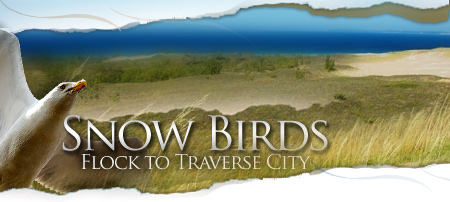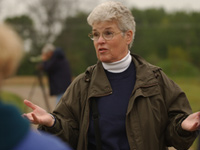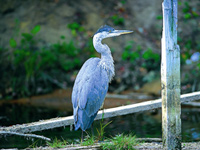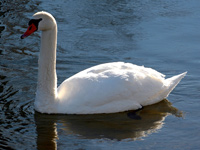| 
Spring Brings Birds & Birdwatchers to Northern Michigan
Each spring, Traverse City witnesses the return of its snowbirds — the hundreds of part-time residents who spend several weeks or months of the year wintering farther south. But they’re not the only birds who start arriving with the spring thaws.
 |
Local birder, Kay Charter, whose bird sanctuary and habitat research center is a must-see for visiting birders |
Thanks to its coastal location along the northern shore of Lake Michigan and its many inland lakes, marshes and ponds, this popular resort community is also a favorite destination for thousands of migratory birds. Like their human counterparts, some of these visitors are only stopping for a few days of relaxation and refreshment while others settle down for the whole summer — but their arrival is cause for excitement among birdwatching enthusiasts.
Although it’s not one of the traditional “hot spots” of the birding universe, the Traverse City area has enough variety of avian species to satisfy a steady stream of birders — particularly in the spring and early summer.
“A lot of neat stuff comes rolling through here each year,” says Nate Crane of the Grand Traverse Audubon Club, one of several groups that conduct year-round bird counts and birding expeditions in the area. “We’re not on any of the main flyways, but we’re close enough that you never really know what you’re going to see from one season to the next.”
Crane has been keeping track of Traverse City’s feathered visitors since he was a youngster, and he’s always delighted when newcomers arrive in the area — whether that’s the trumpeter swans that suddenly began showing up in 2007 or the Eurasian collared doves and Bohemian waxwings that were the talk of the local birding community in early 2008.
“There’s a bird called the whimbrel that travels thousands of miles when it migrates, and we have a window of about two weeks in May when they stop here on their way to Hudson Bay,” Crane said of when to come. “You can go out to the tip of the Leelanau Peninsula in the morning and see them out in the water, sitting on the rocks. It’s pretty cool.”
Fortunately, the same natural features that attract avian migrants to Traverse City’s beaches, lakes and forests also make it a favorite destination for the humans who follow them. As a result, the area gets more attention from birders than it would if it had to rely exclusively on its reputation as a birdwatching mecca.
“It’s kind of a two-fer,” says birder Cindee DuBey. “You get to enjoy a great vacation and do some great birding too.”
 |
Blue Heron can be seen in Traverse City |
The local tourism industry is belatedly taking notice of the phenomenon -- and rightly so, since birding is now the country’s number-one outdoor sport. The U.S. Fish and Wildlife Service estimates that there are currently 51.3 million birders, and the number is still growing. Several local lodges list birding areas in their literature and a few arrange guided outings on request.
Those outings may encompass such locations as the Sleeping Bear Dunes National Lakeshore, where birders can usually find a large variety of songbirds: prairie warblers, pine warblers, Nashville warblers, American redstarts, black-throated blues and even a Blackburnian warbler. They have been sighted along here in mid-May. Thanks to the efforts of the National Park Service, the lakeshore is also home to a recovering population of piping plovers — tiny shorebirds whose habitat has been wiped out.
Another rare bird can be found an hour’s drive to the east, in the jackpine plains near Grayling and Mio. This is the home of the Kirtland’s warbler, a reclusive songbird that requires frequent wildfires to germinate the gnarled pines on which its survival depends. Visitors are only admitted to the warbler’s nesting grounds on an official guided tour.
For birders with less exotic tastes, however, there are plenty of great spots within a few minutes of any Traverse City resort or hotel. The best winter birding in the area, for instance, is probably Medalie Park, at the south end of Boardman Lake. The park is a year-round gathering spot for waterfowl — both migrants and year-round residents, including a large population of mute swans.
Spring brings many more choices, from the extensive trail system of the Grand Traverse Commons (a former mental asylum surrounded by 300 acres of forest, wetlands and meadow) to the Grand Traverse Education Reserve, which skirts both banks of the Boardman River just south of the city.
Southwest of the city, near the village of Interlochen, is Lake Dubonnet, where loons, osprey and trumpeter swans have nested in recent years. (The nearby woodlands are prime warbler habitat.) To the north, at the tip of the scenic Old Mission Peninsula, there are deep coastal woods where pileated woodpecker and black-throated green warblers can be spotted. In spring, this peninsula is a favorite resting spot for birds of prey, which rest and feed there before crossing Lake Michigan on their spring migration to Canada.
 |
Mute Swan is one of Traverse City’s most notable water birds |
An even larger migration takes place just to the west at the end of the larger Leelanau Peninsula, where the woods and wetlands of the Leelanau State Park provide cover for hundreds of migrating songbirds, raptors and waterfowl. Nearby is the 44-acre Charter Sanctuary, established by veteran birders Jim and Kay Charter as a safe haven for over 130 species of migrating, nesting and resident birds — including black-billed cuckoos, grasshopper sparrows and bobolinks. Next door to the sanctuary is the Charters’ educational center, Saving Birds thru Habitat, which shows private landowners how to adapt yards, woodlots and vacant property as bird habitat.
To the northeast, the Yuba Creek Natural Area provides an easily accessible overlook from which viewers with scopes or binoculars can keep tabs on a nesting site for bald eagles. A few miles to the north is the Petobego Pond flooding, an excellent site for watching waders and waterbirds, while the nearby Sand Lakes Quiet Area, Skegemog Swamp Pathway, and Grass River Natural Area provide even more opportunities to spot waterfowl and woodland birds.
When to Come
Spring and early summer are the best time to witness the stream of migrant birds passing through the Traverse City Area, although summer and winter can also provide many interesting opportunities. Specific information about sightings and viewing spots, as well as a schedule of birding outings, can be obtained through the Grand Traverse Audubon Club.
For help with lodging and dining options, and to learn about other adventures, activities and attractions in the Traverse City area, contact the Traverse City Convention & Visitors Bureau.
If You Go…
Traverse City Convention & Visitors Bureau
101 W. Grandview Parkway
Traverse City , MI 49684
1-800-TRAVERSE
(231) 947-1120
Grand Traverse Audubon Club
Email: info2@grandtraverseaudubon.org
Saving Birds Through Habitat
P.O. Box 288
Omena, MI 49674-0288
(231) 271-3738
Email: BOBOLINK3@prodigy.net
Source: Traverse City Convention Visitors Bureau
|